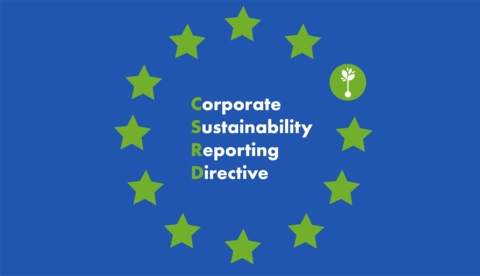Membri
What to expect from the upcoming Corporate Sustainability Reporting Directive (CSRD)

At the beginning of 2020, the President of the European Commission Ursula Von der Leyen, presented the European Climate Law. This proposal sets in stone the European Objective to become climate neutral in 2050 in line with the Paris Agreements of 2015. To support the EU’s goals, investors need quality and comparable data from companies to reorient capital flows toward a sustainable economy while avoiding greenwashing.
In this line, the European Commission has adopted a sustainable finance package, including the Corporate Sustainability Reporting Directive (CSRD) and the EU Taxonomy. The CSRD redesigns the existing Non-Financial Reporting Directive (NFRD 2014/95/EU) by extending the scope to all large companies by January 2023 and to all SMEs by 2026. In addition, it will oblige EU Companies to carry out a full ESG report including a carbon assessment Scope 1-2-3.
The European Commission aims to adopt a first set of sustainability reporting standards by the 31st of October 2022. Nevertheless, several draft reports have already been released. The most up to date working paper, the climate standard prototype working paper, defines the European Sustainability reporting standards.
In addition to current NFRD requirements, the CSDR will impose climate standards including, Business Strategy, Risks, Governance, Policies, Targets and finally Actions.
The European Companies will have to disclose Scope 1-2-3 GHG emissions in absolute value over the past three years in relation to a base year to allow investors and other stakeholders to undertake evolution analysis and monitoring the performance.
Scope 3 categories will be summarized to five overarching categories: 1) upstream purchasing, 2) downstream sold products, 3) goods transportation, 4) business travels and 5) financial investments. These general categories will have to include at least 80% of total Scope 3 emissions.
Based on the results of the Scope 1-2-3 carbon assessment, climate targets should be aimed at being aligned the 1.5°C climate target Paris Agreements target and the EU Climate Law (-55% in 2030 and carbon neutrality in 2050). Therefore, the trajectory should be disclosed in a graph with reference to a 1.5°C scenario. The target years should be 2030 and 2050 with milestones every 5 years from 2025 to 2050.
The reporting should be reported into the management report in electronic format (XHMTL) after being submitted to 3rd party mandatory assurance. According to its NACE activity sector code, each company will be required to assess specific sustainability matters
Therefore, the CSRD will introduce the obligation to carry out a carbon footprint assessment coupled with a monitoring of their environmental, social and governance impacts which will constitute the full ESG Report. This report will have to follow specific guidelines regarding the type of information disclosed, their complexity and the selected format.
About ECONOS
ECONOS is a consulting firm specialized in sustainable development based in Bucharest. We support our clients on the sustainable disclosures required by Romanian and European law. ECONOS is proud to operate Romania’s first carbon assessment software carrying out a Scope 1-2-3 carbon footprint analysis becoming mandatory from next year. Our partnerships with private and public institutions allow us a unique expertise on sustainable requirements in Romania. Let's work together on your company's sustainable development!
ECONOS
mathieu@econos.consulting
+40 754 680 466

